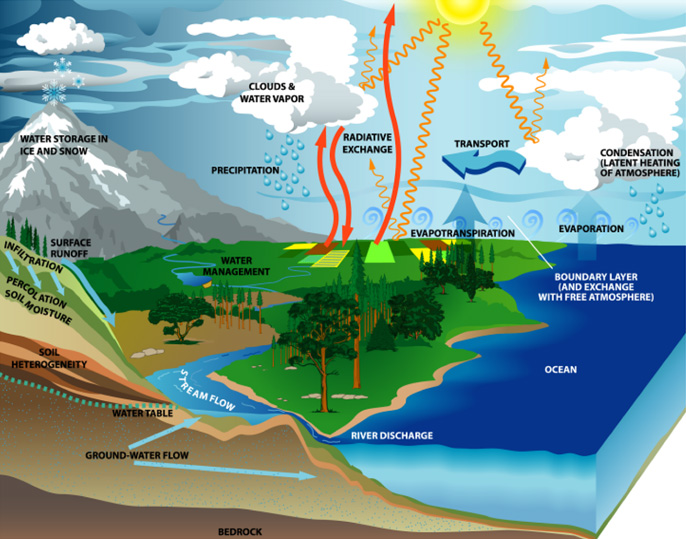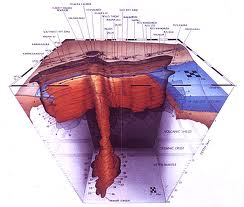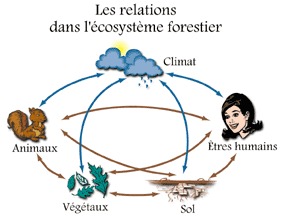
Time Mandala
The natural cycle of water:

A/ Appearance of the living:
Flavonoids are widely distributed in the plant Kingdom where they are present more often in the soluble form of glycosides. They are common among Bryophyta (mosses and liverworts), Pteridophyta (ferns) and the Gymnospermae (conifers) but it is in the Angiospermae that they manifest the greatest diversity.
Context
Trace elements irons are the direct for pigmentation and colouring of plants thus, food of the flavonoids. Regards animals and men, it is an essential micronutrient for oxygenation of blood and metabolism: it is the cofactor, iron appears to be the most complex element handle for simple organisms and human beings living...
For plants:
What are the symptoms? A lack of iron occurs first at level young leaves by chlorosis between the secondary veins, while the main remain green.
It often happens that foliage take a yellow hue similar to the fall colors. It is not uncommon that whiten fabrics. Also, the margin of young leaves will darken.
In severe cases, mature leaves may be affected. Iron-deficient plants may have shorter stems. At the root level, a lack of this element changes the morphology of the latter (the root elongation ceases, their end extends and root hairs proliferate).
For man: a low iron level
Iron deficiency is the most common nutritional deficiency and the leading cause of anemia. Fatigue, pallor, and hair loss are all symptoms of this lack which may result in anemia, i.e. to poor oxygenation of blood.
As well as iron not must not be taken into excess by man...
B / Evidence and Causes of the existence of Gigantism:
BACKGROUND NATURAL:
The pituitary gland which secretes more hormones and in particular those of growth averaged affects 1/30 000 people... This is a phenomenon and an adventure with a risk of multiple cancers (at the level of the pituitary gland) that may occur during the growth of the individual but, more rarely towards maturity...
Comments:
An association between germline aryl hydrocarbon receptor protein mutations interacting with genes (AIP) and pituitary adenomas has recently shown.
(63 Irish families affected)
The aryl hydrocarbon receptor (AhR or AHR) is a member of the family of basic Helix-loop-Helix transcription factors. Data physiological ligands for this receptor are unknown, but it binds several exogenous ligands such as natural flavonoids from plants *, polyphonic compounds and indoles, as well as synthesis of polycyclic aromatic hydrocarbons and dioxin compounds... These compounds are beneficial for the organism or not: as dioxin which is very toxic to the body...
Light on cases of gigantismes:
Significant study of Gigantism:
Human Size Record:
Definition 1: Pituitary gland (in the center of the brain, protects the saddle) gland controlling the trophic hormones, itself controlled by the hypothalamus... It was long believed that the pituitary gland was the mistress of the brain, until recent studies gland. the hypothalamus controls the reproductive functions, thermoregulation, and circadian rhythm or even hunger...
Definition 2: The ligands are molecules or anions, minerals or organic, simple or complex, likely to form complex with cations or metal; through coordination bonds (via the strong links) by transferring one or more electronic doublet...
Definition 3: Electronic Doublet: set of two electrons forming a covalent or this link on a hybrid orbit...
C / Inter activity of living beings:
Facts:
Qualification trace element does not refer to the Silicon quantity of this substance in nature, but in the concentration more in human tissues. Although in there is not more than 7 grams in total in our body, the Silicon is present in almost each of our cells. Specially the cells at rapid growth such as those of the skin, hair and nails contain a large amount of Silicon.
However, the rate of Silicon in our body decreases as we age. Tone and flexibility of the connective tissue are also falling and the ability to absorb water also decreases. Silicon promotes the skin's ability to absorb water and has a positive influence on the metabolism. Simultaneously, it helps in the formation of connective tissue and promotes the growth of hair and nails. Given that the human being needs silicon to his duties, this trace element should be made continuously through food.
Silicon is found associated with glycosaminoglycans and the polyuronides: chondroitin sulfate, dermatan-sulfate and keratan sulfate, heparan-sulfate and heparin. Hyaluronic acid is the richest in Silicon macromolecule. Silicon is also involved in the synthesis of collagen (3 to 6 Si atoms by alpha chain) and elastin. The aorta is located be tissue that contains the most with the skin and the thymus. The rate of Silicon in these tissues decreases with age in proportions very important: loss of about 80-90% (study in rabbits). The decrease of Silicon in the arterial walls is correlated with the fragmentation of elastin and loss of elasticity. More an artery is atheroclereuse least it contains silica and more it is rigid. A high cholesterol diet causes experimental atherosclerosis in the rabbit. The administration of organic silicon prevents fragmentation of elastin fibres. Rigid pipe leads less throughput than a hose. The restoration of the arterial elasticity - compliance - would no doubt help to decrease high blood pressure...
Silicon is essential but very fleeting in the body...
Functions of flavonoids in plants
Flavonoids are widely distributed in plants fulfilling many functions.
Flavonoids are the most important of the plant pigments for the colouring of flower producing yellow or red pigmentation / blue in the petals to attract animal pollinators.
In higher plants, flavonoids are involved in UV filtration, symbiotic nitrogen fixation, and flower pigmentation.
They can act as a chemical Messenger or a physiological regulator, they can also act as inhibitors of cell cycle.
Flavonoids secreted by the root, helps the plant host rhizobia in the stage of infection of their symbiosis with legumes as peas, beans, clover and soybeans. Life of rhizobia in the soil are able to detect the flavonoids, which triggers the secretion of Nod factors, which are in turn recognized by the host plant and can lead to the root of the hair and the deformation of several cellular responses such as the flow of ions and formation of a root nodule.
In addition, some flavonoids have inhibitory activity against organisms that cause, e.g. Fusarium oxysporum. Diseases of plants
The potential beneficial effects on human health
Flavonoids (particularly flav a cannabinoids such as catechins) are "the group the most common of polyphonic compound in the human diet and are found ubiquitously in plants". The flavonols, original Bioflavonoids such as quercetin, are also ubiquitous, but in lesser quantities.
Dissemination of flavonoids, their variety and their relatively low toxicity compared to other active plants (e.g. alkaloids) means that many animals, including humans, in ingerent of significant amounts in their diet. Preliminary research indicate that flavonoids can alter the allergens, viruses, and carcinogens, and therefore may be biological "response modifiers". In vitro studies show that flavonoids have properties anti - allergic, anti-inflammatory, anti-microbial, anti-cancer and anti-diarrheal function for their effects.
Iron is responsible for pigmentation and colouring for plants,
plants may contain up to 10% of Silicon (responsible for the rapid growth)
We see the same needs for arthropods (large families of insects or Arachnids). Essential to aphids nutrient compounds include amino acids, water-soluble vitamins, including Ascorbic acid, mineral salts and sucrose. In some cases, symbiotic microorganisms provide their greenfly hosts some nutrients, including amino acids, vitamins, and sterol. In addition, feeding sucrose and certain amino compounds properties have been demonstrated experimentally, as well as the influence of the pH and the quality of light on food intake. The results of multiple choice tests, in which different nutrient regimes were accessible to the greenfly, clearly demonstrated that these insects can choose between the regimes and prefer those who are superior nutritional value, i.e. those on which their growth, reproduction and survival are maximum...
Iron is also the cofactor of oxygenation and metabolism to animals...
Silicon for humans is vital for the flexibility of the body's cells and the set of cells a rapid growth.
Contact of myself with the source:
It is well known that the vegetation grows much better and is more lush part of mountain which had
a volcanic eruption, a few years later...
RECOVERY OF VEGETATION AFTER A VOLCANIC ERUPTION


D / Analysis comparisons:
A Source as Possible and cause the Gigantism of some animals (like Spinosaurus ) on the site, could be basalt in indirect ways: plant is by feeding first. The basalt was present in large quantities, tens of millions of years earlier... Now specimens are oxidized, in general. Note that dioxin may be present in the basalt immediately after a volcanic eruption, but it disintegrates on ten years...
The source of basalt coincides with the location of a few giant fossils discovered has about 30 m near...Basalt in this region is virtually non-existent, then the coincidence is perhaps the source!
No CRPG |
Demandeur |
Échantillon REF |
SiO2 |
AL2O3 |
Fe2O3 |
MnO |
MgO |
CaO |
Na2O |
K2O |
TiO2 |
P2O5 |
Pertes | Total | ||||||
Pourcentage |
0 % |
0 % |
0 % |
0 % |
0 % |
0 % |
0 % |
0 % |
0 % |
0 % |
0 % |
0 % |
||||||||
SARM |
1203262 |
Jégaden |
Amidijepass Bronze |
53.14 |
0,58 |
40.32 |
0,14 |
0,17 |
0,13 |
0,03 |
0,06 |
0,08 |
0,09 |
5,47 |
100,21 |
|||||
SARM |
512193 |
Jégaden |
Basalte S27 |
51.04 |
16.21 |
9.19 |
0,14 |
5,86 |
9,9 |
3.28 |
1.23 |
1,38 |
0,32 |
1,95 |
100,49 |
|||||
1928 |
Université d'Oklahoma |
Basalte de Black Mesa |
50.96 |
17,54 |
10.47 |
0,12 |
5.17 |
9.18 |
2.78 |
0,54 |
1.31 |
0,54 |
0,12 |
99,62 |
||||||
1928 |
Université d'Oklahoma |
Granfield basalte |
49,6 |
15,86 |
18.56 |
0,09 |
1,92 |
7.03 |
0,93 |
2.12 |
0,65 |
0,21 |
0,25 |
99,61 |
Analysis number 1203262 and 512193 were made with the Service analysis of rocks and minerals in France (Vandoeuvre Les nancy) and the Oklahoma University analyses were made in 1928 at Normand (USA)... These analytical data sets may be subject to copyrights.
When we look at the analysis of Amidijepass Bronze, we can see that the impactite has a huge iron levels, this corresponds 31,44% of non-oxidized iron, this iron seems a bit special...
When we look at the analysis of Amidijepass Bronze, we can see that the impactite has a rate of Silicon strong, this corresponds 24.44% of Silicon;
The aluminium oxide is very low in Amidijepass Alloy, aluminum is toxic to all beings living: so it's really very good that it is almost absent for the appearance of life!
And finally when we look at the rate of the other major oxides, we realize that it is very small! Which raises many questions.
The infinitely small has a lot of similarities with the infinitely large...
E / Unit system:
Microscopic origin of Ferromagnetism
The theory of integrals (or interactions) Exchange proposed by Heisenberg in 1928 is the theoretical basis of explanations of this phenomenon. When a solid is composed of ParaMagnetic atoms (each atom can be likened to a small magnet), there is a coupling between them.
Paramagnetism is magnetic behavior of a material medium has no spontaneous magnetization but which, under the effect of an external magnetic field, acquires a magnetization headed in the same direction as this field of excitement. A Paramagnetic material has therefore a magnetic susceptibility of positive value (unlike the diamagnetic materials), in general quite low. This magnetization disappears when the driving field is switched off, therefore there is no phenomenon of Hysteresis as for Ferromagnetism.
The elements of loss to the fire: (calcination) may be water and gases that play a major role even if they do not fit in the table of chemical analysis oxides: therefore elements are present in the loss to the fire...
The manganese dioxide: can serve as a catalyst. It is used as an oxidant in organic chemistry (e.g. the treatment of manganese for drinking water). For Electronics: as capacitor, but will need to outsource it, this may concern my analysis presents...
Definition 4:Catalysis is the action of a substance called catalyst on a chemical transformation to increase its rate of reaction. The catalyst, which is typically much lower than the reagents is not consumes and is found unchanged at the end of the reaction. If it is separable from the reaction mixture, which is the case of heterogeneous catalysts, it is uses in theory / indefinitely.
Rate of manganese in basalt S27 has the normal levels found in nature, so I can consider the element of connections to the environmental medium.
Manganese and its cell utility
Superoxide dismutase: SOD
In humans, there is coexistence of three forms of SOD. A type of CuZn-SOD (SOD1) is located in the cytoplasm , the Mn - SOD (SOD2) is mitochondria and a second type of CuZn-SOD (SOD3) is extracellular...
In humans
The size of the human mitochondrial proteome is estimated at more than a thousand of proteins, including about 1% encoded by the mitochondrial genome (13 proteins) which currently half is identified. Only 13 proteins are encoded by mitochondrial DNA...
Rare specimens from Bronze Amidijepass:

We can imagine that basalt is replaced quickly enough by the nutrient minerals that appear quite: basalt being covered with Earth...